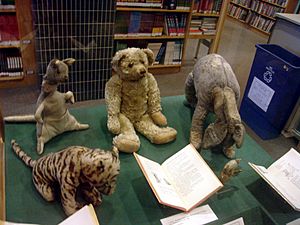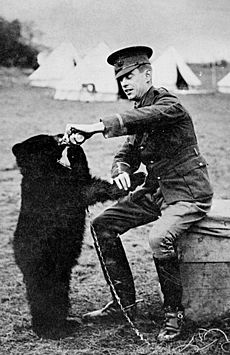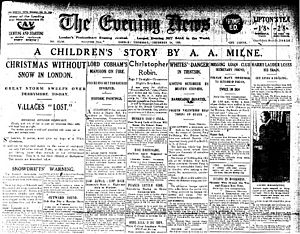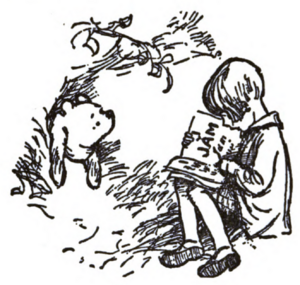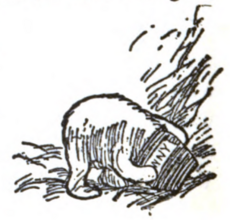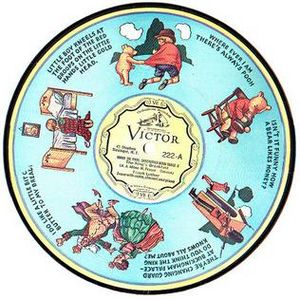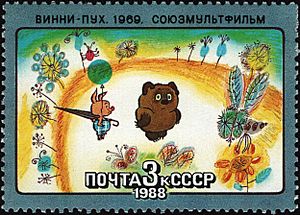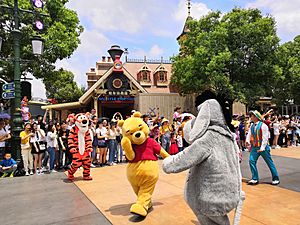Winnie the Pooh facts for kids
Quick facts for kids Winnie-the-Pooh |
|
|---|---|
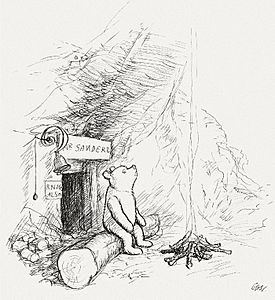
Pooh in an illustration by E. H. Shepard
|
|
| First appearance |
|
| Created by | |
| Information | |
| Nickname(s) |
|
| Species | Teddy Bear |
| Gender | Male |
| Home | Hundred Acre Wood |
Winnie-the-Pooh is a famous teddy bear character. He is also known as Edward Bear, Pooh Bear, or just Pooh. English author A. A. Milne and illustrator E. H. Shepard created him. Winnie-the-Pooh first appeared in a Christmas story in the Evening News newspaper in 1925.
The character was inspired by a stuffed toy that Milne bought for his son, Christopher Robin. The first book of stories about Pooh was Winnie-the-Pooh (1926). Another book, The House at Pooh Corner, followed in 1928. Milne also wrote poems about Pooh in When We Were Very Young (1924) and Now We Are Six (1927). E. H. Shepard drew all the pictures for these books.
The Pooh stories take place in the Hundred Acre Wood. This place was inspired by a real forest called Five Hundred Acre Wood. It is in Ashdown Forest in East Sussex, England. This area is about 30 miles (48 km) south of London. Milne had a country home there.
Pooh stories have been translated into many languages. One famous translation is into Latin, called Winnie ille Pu. It was published in 1958. In 1960, it became the only Latin book to ever appear on The New York Times Best Seller list. The original English writings are kept at Wren Library, Trinity College, Cambridge. Milne gave them to his old college.
In 1961, The Walt Disney Company bought the rights to make movies and other things from the Winnie-the-Pooh stories. Disney made many popular movies and shows. They used the name "Winnie the Pooh" without the hyphen. Pooh has been voiced by actors like Sterling Holloway and Jim Cummings in English.
Contents
The Story of Pooh: How He Began
Where Winnie-the-Pooh Came From
A. A. Milne named Winnie-the-Pooh after a teddy bear that belonged to his son, Christopher Robin Milne. The character Christopher Robin in the books is based on Milne's son. The artist, Shepard, drew Pooh based on his own son's teddy bear, Growler. He did not use Christopher Robin's bear.
Many of Christopher Milne's other toys became characters in the stories. These include Piglet, Eeyore, Kanga, Roo, and Tigger. Milne imagined two other characters, Owl and Rabbit. The character Gopher was added later in the Disney versions. Christopher Robin's toy bear is now on display at the New York Public Library in New York City.
In 1921, Milne bought his son Christopher Robin the teddy bear from Harrods department store. Christopher Robin named his toy bear after two real animals. One was a Canadian black bear named Winnie. Christopher Robin often saw her at the London Zoo. The other was a swan named Pooh, who was a friend's pet.
The real bear cub, Winnie, was bought by a Canadian soldier named Lieutenant Harry Colebourn in 1914. He bought her for C$20 while traveling to England during World War I. Colebourn named the bear Winnie after his hometown, Winnipeg, Manitoba. He secretly brought Winnie to England. She became a mascot for his army group. Colebourn left Winnie at the London Zoo when he went to France. After the war, he gave her to the zoo officially. She was a very popular animal there. The swan named Pooh also appears as a character in Milne's book When We Were Very Young.
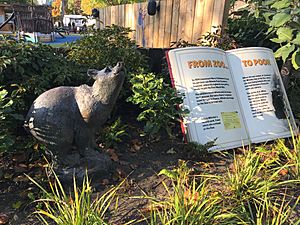
In the first chapter of Winnie-the-Pooh, Milne explains why the bear is sometimes called "Pooh":
But his arms were so stiff ... they stayed up straight in the air for more than a week, and whenever a fly came and settled on his nose he had to blow it off. And I think – but I am not sure – that that is why he is always called Pooh.
Ashdown Forest: The Real Hundred Acre Wood
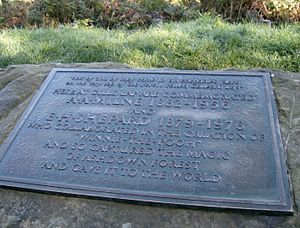
The Winnie-the-Pooh stories are set in Ashdown Forest in East Sussex, England. This forest has open heathland on sandy hills. It is about 30 miles (50 km) south-east of London. In 1925, Milne, who lived in London, bought a country home near the forest.
Christopher Robin Milne said that his family would visit the forest every weekend and for long holidays. They would explore the area. His father, A. A. Milne, was inspired by Ashdown Forest. He used it as the setting for two of his books.
Many places in the stories are based on real spots in the forest. Christopher Milne wrote that "Pooh’s forest and Ashdown Forest are identical." For example, the fictional "Hundred Acre Wood" is really Five Hundred Acre Wood. Galleon's Leap was inspired by a hill called Gill's Lap. A group of trees near Gill's Lap became Christopher Robin's The Enchanted Place. No one could ever count how many trees were there.
E. H. Shepard's drawings for the Pooh books show the real landscape of Ashdown Forest. It has open areas with heather, gorse, and pine trees on hills. Many of Shepard's drawings match real views from the forest. His sketches of the forest are kept at the Victoria and Albert Museum in London.
The game of Poohsticks was first played by Christopher Robin Milne and his father. They played it on a wooden bridge over the Millbrook, near their home. In the stories, Pooh plays this game with Christopher Robin, Tigger, and Eeyore. This bridge is now a popular place for tourists. People often play Poohsticks there using sticks from the nearby woods. When the bridge was rebuilt in 1999, the new design kept the original style from Shepard's drawings.
How Pooh Stories Were First Published
Christopher Robin's teddy bear first appeared as a character named Edward. This was in A. A. Milne's poem "Teddy Bear." It was published in Punch on February 13, 1924. The same poem was in Milne's book When We Were Very Young later that year.
Winnie-the-Pooh first appeared by his full name on December 24, 1925. This was in a Christmas story for the London newspaper Evening News. The story was illustrated by J. H. Dowd.
The first collection of Pooh stories came out in the book Winnie-the-Pooh. The Evening News Christmas story became the first chapter of this book. The book explained that Pooh was Christopher Robin's Edward Bear, who had been renamed. He was named after a real American black bear at London Zoo called Winnie. She got her name because her owner came from Winnipeg, Canada.
The book was published in October 1926. It was an instant success. A children's author, John Rowe Townsend, called Winnie-the-Pooh and its next book The House at Pooh Corner "the spectacular British success of the 1920s." He praised its easy-to-read writing style.
How Pooh Looks
The first drawing of Pooh was not based on Christopher Robin's bear. It was based on Growler, the teddy bear of Shepard's son, Graham. James Campbell, who manages Shepard's estate, found many old drawings. He said that both Shepard and Milne thought Christopher Robin's bear looked "too gruff." They wanted a different bear for the pictures. Campbell said Shepard sent Milne a drawing of his son's bear, and Milne "said it was perfect." Shepard also based his drawings of Christopher Robin partly on his own son.
Winnie-the-Pooh's Personality
In Milne's books, Pooh is a bit naive and not very quick-witted. But he is always friendly, caring, and loyal. He and his friends agree he is "a bear of very little brain." Still, Pooh sometimes has clever ideas, usually based on common sense.
For example, he rode in Christopher Robin's umbrella to save Piglet from a flood. He found "the North Pole" by picking it up to help Roo out of the river. He also invented the game of Poohsticks. And he helped Eeyore out of the river by dropping a big rock to push him to the bank.
Pooh is also a talented poet. His stories often include his poems and "hums." He is humble about his simple mind but confident in his creative skills. When Owl's house blows down, Pooh encourages Piglet to escape and save them. He promises to write "a respectful Pooh song" about Piglet's brave act.
Pooh loves food, especially honey (which he spells "hunny"). He also likes condensed milk. When he visits friends, he wants a snack but tries not to ask directly. He once ate a pot of honey he meant to give Eeyore for his birthday. So, he gave Eeyore "a useful pot to put things in" instead. Pooh always tries to have "a little something" around 11:00 in the morning. Since his clock stopped, any time can be snack time for Pooh!
Pooh is very social. His best friend after Christopher Robin is Piglet. He often spends time with them. But he also visits other animals, often hoping for a snack or an audience for his poems. He is kind-hearted and goes out of his way to be friendly to Eeyore. He visits Eeyore, brings him birthday presents, and even builds him a house. This is true even though Eeyore is often grumpy.
Later Stories and Disney's Pooh
New Adventures of Winnie-the-Pooh
An official new story, Return to the Hundred Acre Wood, was published in 2009. The author, David Benedictus, kept Milne's characters the same. The pictures, by Mark Burgess, look like Shepard's drawings.
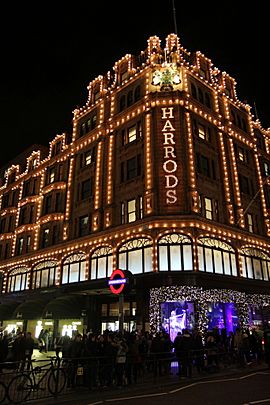
Another official sequel, Winnie-the-Pooh: The Best Bear in All the World, came out in 2016. It has four short stories by different children's authors. This book introduces a new character, Penguin. This was inspired by an old photo of Milne and his son with a toy penguin.
In 2016, Winnie-the-Pooh Meets the Queen was published. It celebrated Milne's creation turning 90 and Queen Elizabeth II's 90th birthday. In this story, Pooh meets the Queen at Buckingham Palace.
In 2021, a new story called Winnie-the-Pooh: Once There Was a Bear was released. It is the first story that happens before Milne's original books. It celebrates 100 years since Milne bought the toy bear that inspired Pooh. Written by Jane Riordan, it is in Milne's style with drawings by Mark Burgess like Shepard's. Pooh explores Harrods, the Natural History Museum, and London Zoo before returning to the Hundred Acre Wood.
Pooh's Red Shirt and Disney's Movies
The first time Pooh appeared in color was in 1932. He was drawn by Stephen Slesinger, who owned some rights to Pooh. In this drawing, Pooh wore his famous red shirt. He was featured on an RCA Victor record. Later, in the 1940s, Agnes Brush made the first plush Pooh dolls with shirts.
After Stephen Slesinger passed away in 1953, his wife, Shirley Slesinger Lasswell, continued to develop the character. In 1961, she gave Walt Disney Productions the rights to Pooh. Milne's widow, Daphne Milne, also gave Disney certain rights that same year.
Since 1966, Disney has made many animated movies and shows about Winnie the Pooh. They started with a short film called Winnie the Pooh and the Honey Tree. This was followed by Winnie the Pooh and the Blustery Day (1968) and Winnie the Pooh and Tigger Too (1974). These three shorts were later combined into a full movie, The Many Adventures of Winnie the Pooh, in 1977.
Disney also made new Pooh movies in the 2000s, like The Tigger Movie (2000) and Winnie the Pooh (2011). They also created TV shows such as The New Adventures of Winnie the Pooh (1988–1991).
In the United States, A.A. Milne's copyright for the Winnie-the-Pooh character ended at the end of 2021. This means the character is now in the public domain there. So, Disney no longer has the only rights to Pooh in the U.S. Because of this, an independent filmmaker made a horror movie called Winnie-the-Pooh: Blood and Honey. The copyright in the United Kingdom will end in 2027.
Other Ways to Enjoy Pooh
Pooh on Stage and in Audio
- 1931. Winnie-the-Pooh puppet show by Sue Hastings Marionettes.
- 1957. Winnie-the-Pooh, a play by Kristin Sergel.
- 1964. Winnie-the-Pooh, a musical comedy.
- 2021. Winnie the Pooh: The New Musical Adaptation.
Many audio recordings of Pooh stories have been made.
- In 1956, Maurice Evans read selected Pooh stories on vinyl records.
- In 1951, RCA Records released four Pooh stories. Jimmy Stewart narrated them, and Cecil Roy voiced Pooh.
- In the 1970s and 1980s, Carol Channing recorded Pooh stories and songs.
- Peter Dennis recorded all four Pooh books without any cuts.
- In the 1990s, the stories were made into audio plays. Stephen Fry voiced Winnie-the-Pooh, and Jane Horrocks voiced Piglet.
Pooh on Radio and Film
- The BBC started reading Winnie-the-Pooh stories on children's programs soon after they were published in 1926.
- Pooh first appeared on US radio on November 10, 1932. He was broadcast to schools by The American School of the Air.
- 2017: Goodbye Christopher Robin, a British movie about how Winnie-the-Pooh was created. Domhnall Gleeson plays A. A. Milne.
- 2018: Christopher Robin, a Disney movie. Ewan McGregor plays an adult Christopher Robin. Parts of the movie were filmed in Ashdown Forest.
Soviet Pooh Cartoons
In the Soviet Union, three Winnie-the-Pooh cartoons were made.
- 1969. Winnie-the-Pooh
- 1971. Winnie-the-Pooh Pays a Visit
- 1972. Winnie-the-Pooh and a Busy Day
These films used Boris Zakhoder's translation of the book. Pooh was voiced by Yevgeny Leonov. The animators did not copy Shepard's drawings. They created their own unique look for the characters. These Soviet cartoons often showed parts of Milne's characters that were not used in the Disney versions.
Pooh on TV
- 1960: Shirley Temple's Storybook on NBC showed a marionette version of Winnie-the-Pooh.
- In the 1970s, the BBC children's TV show Jackanory read the two Pooh books.
- 2024: An untitled animated series is planned.
Winnie-the-Pooh's Big Impact
Maev Kennedy from The Guardian newspaper called Winnie-the-Pooh "the most famous bear in literary history." He is one of the best-known characters in British children's literature. In a 2011 poll, Pooh was voted one of the top 100 "icons of England." In 2003, the first Pooh story was ranked number 7 in the BBC's The Big Read poll.
Forbes magazine said Pooh was the most valuable fictional character in 2002. Products with Pooh on them made over $5.9 billion that year. In 2005, Pooh made $6 billion, which was only less than Mickey Mouse. In 2006, Pooh got a star on the Hollywood Walk of Fame. This celebrated 80 years since Milne created him. In 2010, E. H. Shepard's original drawings of Pooh appeared on UK postage stamps.

Winnie the Pooh has inspired books that explain big ideas. Benjamin Hoff used Milne's characters in The Tao of Pooh to explain Taoism. Other writers have used Pooh to explore philosophy or even to make fun of academic writing.
In music, Kenny Loggins wrote the song "House at Pooh Corner." He later rewrote it as "Return to Pooh Corner." In Italy, a pop band named themselves Pooh. In Estonia, there is a band called Winny Puhh. There is a street in Warsaw, Poland, named after the character, called Kubusia Puchatka Street. He is known as Kubuś Puchatek in Polish. There is also a street named after him in Budapest, Hungary.
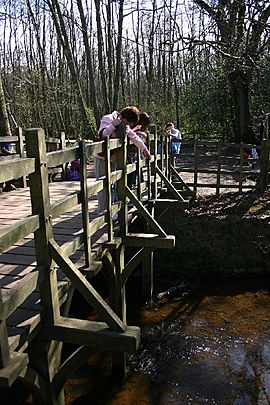
The "sport" of Poohsticks is a real game. Players drop sticks into a stream from a bridge. Then they watch to see whose stick crosses the finish line first. This game started with Pooh and his friends in the book The House at Pooh Corner. Now, a World Championship Poohsticks race happens in Oxfordshire every year. Ashdown Forest, where the stories are set, is a popular place to visit. It includes the wooden Pooh Bridge where Pooh and Piglet invented Poohsticks. The Oxford University Winnie the Pooh Society was started by students in 1982.
From 2017 to 2018, the Victoria and Albert Museum in London had an exhibition called Winnie-the-Pooh: Exploring a Classic. It showed A. A. Milne's original writings for Winnie-the-Pooh and The House at Pooh Corner. It also showed the real teddy bears that inspired the characters.
In 2018, E. H. Shepard's original 1926 map of the Hundred Acre Wood was sold for a lot of money. It sold for £430,000 ($600,000) at Sotheby's in London. This set a world record for book illustrations.
The Japanese figure skater Yuzuru Hanyu thinks Pooh is his lucky charm. He often has a stuffed Winnie-the-Pooh with him at competitions. Because of this, Hanyu's fans throw stuffed Winnie-the-Poohs onto the ice after he performs. After one of his performances, someone said "the ice turned yellow" because of all the Poohs!
Pooh and Chinese Politics
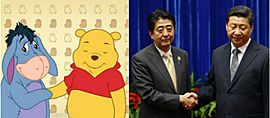
In China, pictures of Pooh were removed from social media websites in 2017. This happened because people started comparing Chinese leader Xi Jinping to Disney's version of Pooh. The 2018 movie Christopher Robin was also not allowed to be shown in China.
See also
 In Spanish: Winnie the Pooh para niños
In Spanish: Winnie the Pooh para niños


